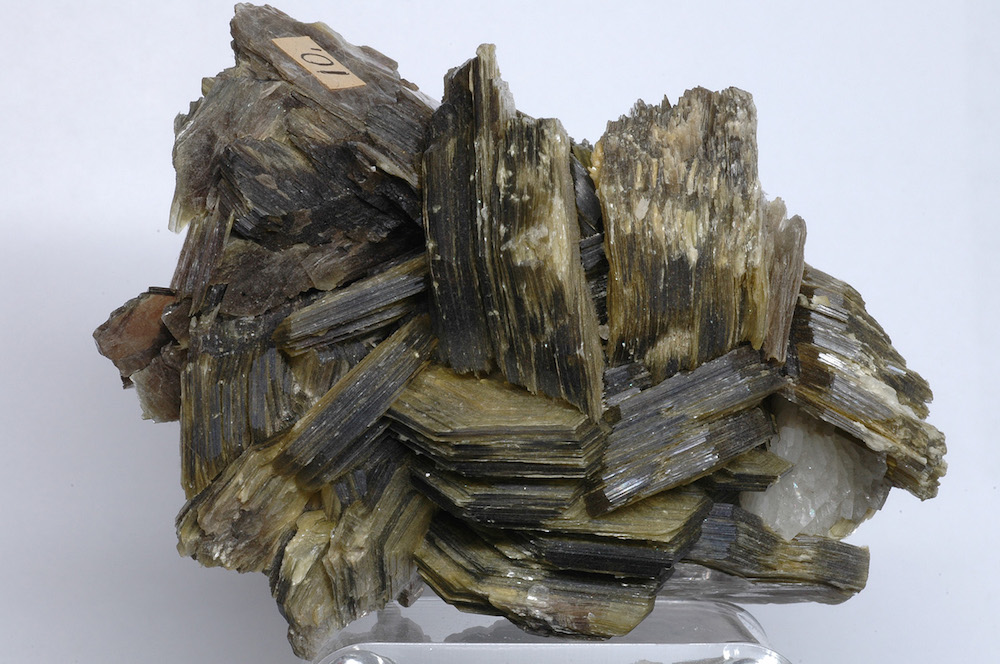
[Image above] Muscovite is one of three mica minerals often considered a clay because of its clay-like properties. Four researchers from Japan looked into how they could predict muscovite friction on the macroscale by using microscale-based calculations. Credit: Jeff-o-matic, Flickr (CC-BY-NC 2.0)
What is friction? The word is a fairly common one, and one that you probably learned the hard way when you experienced your first serious rug burn. Friction is the resistance that one surface (such as your knee) experiences when it moves over another surface (such as carpet), and the resistance produces heat—leading you to run for cold water to soothe your chafed skin.
But what causes friction? The answer to that question is a bit more complicated. There are various theories that explain why two surfaces might resist each other. Some theories focus on the microscale—chemical bonding, be that ionic, covalent, or hydrogen; and electrical effects, such as van der Waals forces. Other theories focus on the macroscale, such as surface roughness.
This complexity behind the mechanisms that cause friction makes friction research an active area of study, and one that covers a variety of fields, from welding to automotive to geology.
Geology in particular sees a lot of research on friction. By understanding what causes friction in different earth materials, geologists can better understand and predict natural disasters such as earthquakes and landslides.
Mica is one earth material that has received a fair amount of attention. Mica refers to a group of minerals known as sheet silicates (because they form in distinct layers) and it makes up approximately 5 percent of Earth’s crust. Minerals in the mica group are closely associated with clay minerals, and three mica minerals—muscovite, glauconite, and illite—are often considered clays due to their clay-like properties.
A number of studies have looked at mica’s role in seismic anisotropy, but the mechanisms that drive frictional forces in mica are still poorly understood. As the researchers of a recent study explain, “The origin of the frictional force has been considered to be the adhesion at contact; however, no correlation has been confirmed between the frictional strength and the adhesive force of sheet-structure minerals.”
These researchers from various institutions in Japan—Hiroshi Sakuma and Shigeru Suehara (National Institute for Materials Science, or NIMS), Kenji Kawai (University of Tokyo), and Ikuo Katayama (Hiroshima University)—worked together to answer the question, “What causes macroscopic friction in mica?”

The researchers analyzed muscovite, one of the three mica minerals often considered clays. To determine the microscopic and macroscopic frictions in muscovite, the researchers used experimental double-direct shear tests and first-principles electronic calculations based on density functional theory (DFT). And, according to a NIMS press release, this approach was successful.
“The research team confirmed for the first time that frictions occurring between the surfaces of clay minerals of tens of centimeters in size [macroscale] are controlled by atomic-scale electrostatic forces [microscale],” the press release states.
In particular, the researchers explain in the paper that microscale friction between muscovite sheets can be explained by roughness of potential energy surfaces (mathematical functions that give the energy of a molecule as a function of its geometry). When these theoretical calculations are then scaled up to predict muscovite friction on the macroscale, they are able to do so with high accuracy as long as the presence of wear particles are taken into consideration.

The press release states that the researchers plan to develop their theory further so that it can explain frictional strength across a broad range of clay minerals in addition to muscovite. If they are successful, “[s]uch theory may provide material design guidelines for friction-reducing solid lubricants and other friction-related products.”
It may come as no surprise that such interesting research on friction in earth materials comes from Japan. After the 2011 Tōhoku earthquake and tsunami struck Japan and caused serious damage—the effects of which still reverberate to this day—Japan has put a lot of research into better understanding and monitoring earthquakes. The friction study was funded in part by a Grant-in-Aid for Scientific Research project to understand intra-island deformation after the Tōhoku earthquake. Check out other research funded by this project here.
The open-access paper, published in Science Advances, is “What is the origin of macroscopic friction?” (DOI: 10.1126/sciadv.aav2268)
